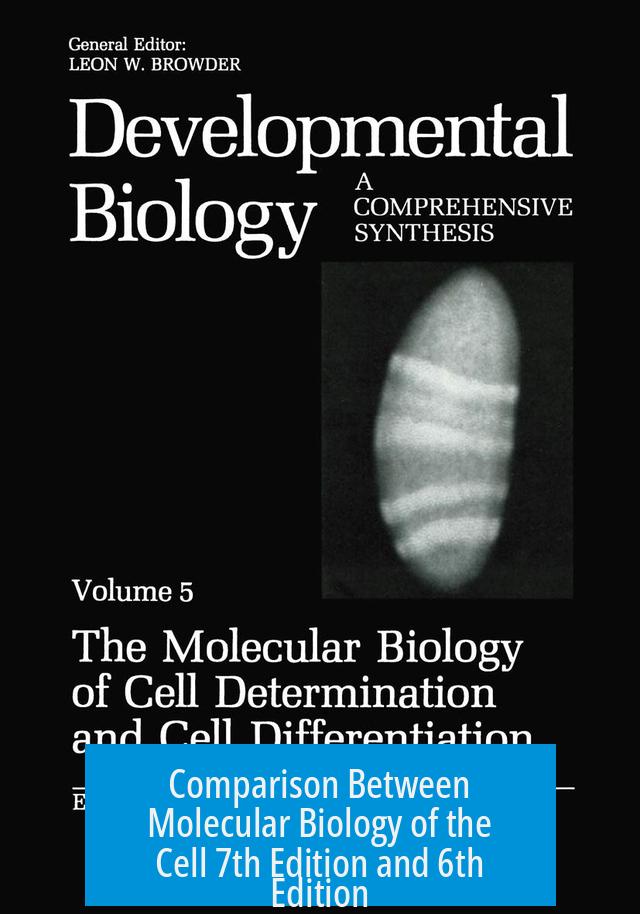Comparison Between Molecular Biology of the Cell 7th Edition and 6th Edition

The 7th edition of Molecular Biology of the Cell significantly updates and expands on the 6th edition in content, illustrations, and supplementary materials while also adapting to recent scientific advances.
Major Content Updates in the 7th Edition
Every chapter in the 7th edition reflects new discoveries and evolving understandings in cell biology. Key advances include extensive updates on the human genome project. For example, the 7th edition incorporates findings from sequencing hundreds of thousands of human genomes (Chapter 4) and refines coverage of tumor genomics (Chapter 20).
Emerging diseases and current global challenges receive attention as well. New sections address pathogen biology and the molecular basis of diseases such as COVID-19 in multiple chapters (1, 5, and 23). This edition explains mRNA vaccine technology, a groundbreaking approach introduced during the pandemic (Chapter 24).
The 7th edition also features deeper insights into cellular architecture and dynamics. It introduces biomolecular condensates—structures that spatially organize cellular components without membranes—across several chapters (3, 6, 7, 12, and 14). Advances in chromosome organization, such as DNA loop extrusion mechanisms, appear in Chapters 4, 7, and 17.
Technological innovations enhance the textbook’s focus. New microscope methods, including superresolution light microscopy and atomic resolution electron microscopy, are detailed in Chapter 9. Fresh breakthroughs from cryo-electron microscopy, like the structure of stretch-activated Piezo channels, are covered in Chapter 11.
The book updates discussions on evolution. It broadens the view on life’s diversity (Chapter 1) and provides up-to-date information on the evolution of humans (Chapter 4) and HIV (Chapter 23).
Illustrations and Format Improvements
The 7th edition refreshes about 25% of its illustrations, enhancing clarity and accuracy. Visuals reflect new scientific data and improve educational impact.
Importantly, this edition introduces an online assessment component called the Digital Problems Book integrated with Smartwork, providing interactive problem-solving tools for students and instructors. This feature reimagines the traditional Problems Book to suit modern educational needs.
Content Removal and Adaptation
To integrate new findings and the extensive COVID-19 related material, some older content was removed or condensed. This pruning ensures that the material remains current and relevant without excessive length.
Practical Advice When Choosing Between Editions
If the textbook is for personal study, the 6th edition remains largely sufficient given foundational content is intact. The 7th edition’s additions are mostly updates on recent discoveries and reorganizations of sections.
For coursework, one should confirm with instructors about the edition preference. Some professors assign readings by chapter rather than page numbers to accommodate different editions. If they assign by page, using the 7th edition or cross-referencing chapters will help avoid confusion.
It is common for instructors to accommodate students who are using older editions.
Author Contributions and Editions
The 7th edition is noted for collaborative authorship, moving beyond Bruce Alberts’ sole authorship in earlier editions. No direct comparison of the two versions of the 7th edition exists, but the multi-author version likely brings broader expertise and updated perspectives.
Summary of Key Differences
- Updated scientific content: Genome research, COVID-19, cellular structures, microscopy innovations.
- New sections: Biomolecular condensates, DNA loop extrusion, mRNA vaccines, viral evolution.
- Illustrations: One-quarter of images are new or enhanced for clarity.
- Digital learning tools: Added online problems via Smartwork platform.
- Content removal: Older content trimmed to include new findings and pandemics topics.
- Practical use: 6th edition still strong for foundational learning; 7th better for cutting-edge topics.
What are the main content updates in the 7th edition compared to the 6th?
The 7th edition includes new discoveries in cell biology. It covers advances in genome research, tumor genomes, COVID-19, mRNA vaccines, biomolecular condensates, and new microscope technologies. Some chapters were significantly expanded or updated.
How different is the illustration and format between the two editions?
About 25% of illustrations in the 7th edition are new or significantly revised for clarity and accuracy. The 7th edition also offers an online assessment tool, which was not in the 6th edition.
Will the changes affect students using older editions for courses?
Most content is similar, but page numbers and chapter orders may differ. Professors usually accommodate this by referring to sections rather than page numbers if you use an older edition.
Were any topics removed to include new information in the 7th edition?
Yes, to add new cell biology topics, including COVID-19 research, some older content was removed. The updates reflect recent advances and focus on current scientific questions.
Is there a notable difference between the single-author and multi-author versions of the 7th edition?
There is no clear information comparing the single-author and multi-author 7th editions. Users often ask, but no detailed comparison or recommendation is provided.





Leave a Comment